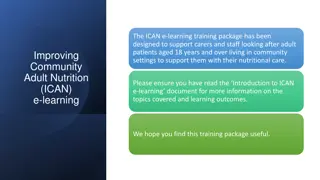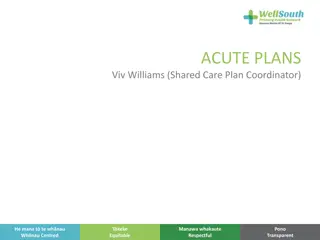Treatment of Acute malnutrition using Simplified Approaches.
Simplified approaches in the treatment of acute malnutrition involve modifications to existing protocols to optimize effectiveness, quality, and cost-efficiency. These approaches include family MUAC screening, CHW-led treatment, reduced follow-up visits, expanded admission criteria, single treatment product usage, optimized dosage, and more. They are particularly useful in areas facing challenges like seasonal malnutrition increases, humanitarian assistance disruptions, and limited resources. The SOP aims to enhance treatment coverage and access for children with wasting in hard-to-reach areas.
Download Presentation

Please find below an Image/Link to download the presentation.
The content on the website is provided AS IS for your information and personal use only. It may not be sold, licensed, or shared on other websites without obtaining consent from the author.If you encounter any issues during the download, it is possible that the publisher has removed the file from their server.
You are allowed to download the files provided on this website for personal or commercial use, subject to the condition that they are used lawfully. All files are the property of their respective owners.
The content on the website is provided AS IS for your information and personal use only. It may not be sold, licensed, or shared on other websites without obtaining consent from the author.
E N D
Presentation Transcript
Treatment of Acute malnutrition using Simplified Approaches. Orientation on the SOP, Jan 10, 2023
What the simplified approaches? Simplified approaches refer to modifications/ simplifications to existing national and global protocols for the treatment of child wasting. These modifications are designed to improve effectiveness, quality, coverage and reduce the cost of caring for children with uncomplicated wasting. The Simplified Approaches can be used to maintain service availability and continuity in exceptional circumstances until standard programming is established or resumes. This Somalia SOP is adapted from the USING SIMPLIFIED APPROACHES IN EXCEPTIONAL CIRCUMSTANCE Guidelines Published by UNICEF in collaboration with the Global Simplified Approaches Working Group.
What the simplified approaches? 1. Family MUAC: Engaging family members to screen and refer their children 2. CHW-led treatment of wasting: Management of wasting by Community Health Workers (CHWs) 3. Reduced Frequency of Follow-up Visits 4. MUAC and oedema only: Admission, treatment, discharge based on Mid-upper arm circumference (MUAC) and/or oedema 5. Expanded admissions criteria: Systematic expansions of MUAC to include more children (e.g., 120mm or 125mm) 6. Use of a single treatment product: Use of ready-to-use food (RUF) for the treatment of all wasted children in need of treatment 7. Optimized Dosage: Treatment dosage of RUTF product modified over course of recovery
Why simplified approaches in NE Nigeria? Lean seasonal increase in prevalence of acute malnutrition. Disruptions in the humanitarian assistance (conflict, funding challenges) Accessibility challenges Pipeline breaks Low coverage Limited human resources and capacities. Mitigation measures context-specific activation of Simplified Approaches (SAs) in hard-to-reach areas.
The SOP Purpose of the SAs a) To improve coverage and access to lifesaving treatment services for uncomplicated wasting among children 6-59 months through existing and newly established service centers at health facility and community level b) To provide a continuum of care for children 6-59 months with wasting in hard-to-reach areas. Tool to guide activation, rollout and implementation of appropriate simplified approaches.
Proposed Simplified Approaches. Expanded admission criteria: MUAC will be expanded; 115mm to 125mm in OTPs (TSFP not active) Using a single product: RUTF for both MAM and SAM with a dosage of 1 sachet for MAM and 2 sachets for SAM CHW-led treatment of wasting: CHWs or volunteers training to manage uncomplicated wasting- screen, register, medicate, distribute RUTF/RUSF, follow up, document and referral. Reduced Frequency of Follow-up Visits: Weekly for SAM cases and fortnightly for MAM cases MUAC and oedema only: Admission, treatment, discharge based on Mid-upper arm circumference (MUAC) and/or oedema. (pitting oedema(+, ++), MUAC <125 mm and no complications) Family MUAC: Engaging family members to screen and refer their child
The SA decision tree Before implementation ensure: All partners, health, local authorities are aware. Operational technical capacity Supplies availability Proper data collection, monitoring, and reporting system Some form of accessibility to Hard-to-reach/ inaccessible areas
Decision pathway: Exceptional circumstances and adoptable simplified approaches.. Expanded Admission Criteria Single Product use (RUTF MUAC and oedema only Family MUAC 1. Pipeline break of nutrition supplies* for the treatment of MAM** OR SAM (stock out, delays) CHW-lead treatment Reduced visits frequency MUAC and oedema only Family MUAC Single product for treatment (RUTF) 2. Hard-to-reach and inaccessible locations (poor accessibility for partners, no SFP)
Decision pathway: Exceptional circumstances and adoptable simplified approaches.. MUAC and oedema only CHW-lead treatment Reduced visits frequency Family MUAC Single product for treatment Expanded admission MUAC. 3. Human resources challenges for CHW-lead treatment Reduced visits frequency Family MUAC 4. Poor services utilization
Decision pathway To note: Service delivery points Health facility/hospital, Outreach/mobile clinic, For CHW-led treatment: community health post, central location in the community, home of a CHW etc Systematic medical treatment: as per the national CMAM guidelines Monitoring/performance indicators: as per the national CMAM guidelines
Key considerations for implementation Community awareness and participation. Communication/training/orientation Pipeline Technical capacity/literacy levels Monitoring of clinical outcomes Potential to couple approaches CHW/V platforms Incentives Supervision Effective referral pathways Safety
Additional information Areas of implementation (to be updated regularly): Areas with exceptional circumstances. Priority: IDPS, hard-to reach areas Implementation period: 3-6 months Caseloads: use the caseload calculator Reporting: based on standard reporting tools, MAM and SAM cases to be separated where expanded criteria is used Both WFH Z scores and MUAC to be used where MUAC- only is not applied. Coordination: led y the NS coordination desk and TWG
Implementation framework Mapping Review of SOP Review Request for supplies Submit request TWG meeting with partners Orientation or training Activation of SAs
Key points Any changes to be done in consultation and coordination with all parties concerned Other aspects of care to follow the national CMAN guidelines. Living document All partners to adhere to SOP. Duration of implementation: temporary/3months/dependent on context evolution























